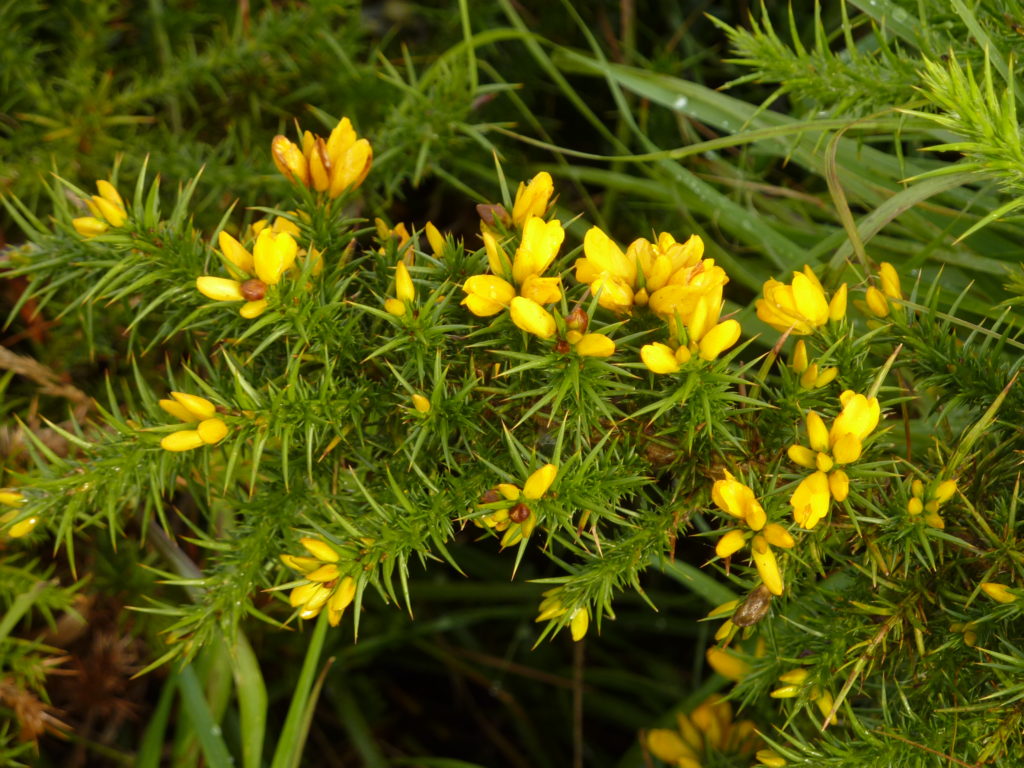
What is now called The Fabaceae, was long known as Leguminosae and commonly these are known as the legume, pea, or bean family.
This is a large and economically important family in the world. It includes trees, shrubs, and perennial or annual herbaceous plants, which are easily recognized by their fruit (legume) and/or their compound, stipulate leaves.
It is not as big in Britain but an interesting and useful family all the same! Credits are due once again to Stace‘s Flora, J. Barker’s Medicinal Flora, Plantlife and Wikipedia for most information. The link on the scientific names are mostly from the Plant Atlas 2020 Online and the information from the habitats is also copied from this Online Atlas. The link on the Common Name is from a website with usually some more info and pictures of the plant. I try and use UK sites as much as possible!
In case there are any medical uses stated with the plants mentioned below, please take sensible advise from a qualified herbalist.
If you would like to learn a bit more about the classification of this large family I can recommend Britannica.com webpage
NN behind the names in the Contents means Non-Native (is similar to neophyte) and has been introduced and often naturalised into the wild. FBBC in the Contents behind the names means that it also occurs in the Flora of Birmingham and the Black Country!
Contents
General information on this important family
Subfamily 1: The Faboideae
Tribe 1: Robineae
Robinia pseudoacacia or False-acacia (NN) FBBC
Tribe 2: Phaseoleae or ‘Beans’
- Phaseolus vulgaris or French Bean (NN)
- P. coccineus or Runner Bean (NN) FBBC
- Vigna radiata or Mung Bean (NN)
- Glycine max or Soyabean (NN)
Tribe 3: Psoraleeae
Cullen americanum or Scurfy Pea (NN)
Tribe 4: Galegeae
- Galega officinalis or Goat’s-rue (NN) FBBC
- Colutea arborescens or Bladder-senna (NN) FBBC
- C. x media or Orange Bladder-senna (NN)
- Astragalus cicer or Chick-pea Milk-vetch (NN)
- A. danicus or Purple Milk-vetch
- A. alpinus or Alpine Milk-vetch
- A. glycyphyllos or Wild Liquorice
- A. odoratus or Lesser Milk-vetch (NN)
- Oxytropis campestris or Yellow Oxytropis
- O. halleri or Purple Oxytropis
Tribe 5: Hedysareae
Onobrychis viciifoli or Sainfoin (NN) FBBC
Tribe 6: Loteae
- Anthyllis vulneraria or Kidney Vetch FBBC
- Lotus hirsutus (Dorycnium hirsutum) or Hairy Canary clover (NN) FBBC
- Lotus tenuis or Narrow-leaved Bird’s-foot-trefoil FBBC
- L. corniculatus or Common Bird’s-foot-trefoil FBBC
- L. corniculatus var. sativus FBBC
- L. pedunculatus or Greater Bird’s-foot-trefoil FBBC
- L. subbiflorus or Hairy Bird’s-foot-trefoil
- L. angustissimus or Slender Bird’s-foot-trefoil
- Tetragonolobus maritimus or Dragon’s-teeth
Tribe 7: Coronilleae
- Ornithopus compressus or Yellow Serradella (NN) FBBC
- O. sativus or Serradella (NN)
- O. perpusillus or Bird’s foot FBBC
- O. pinnatus or Orange Bird’s- foot
- Coronilla valentina or Shrubby Scorpion-vetch (NN)
- C. scorpioides or Annual Scorpion-vetch (NN)
- Hippocrepis comosa or Horseshoe Vetch
- H. emerus or Scorpion Senna (NN)
- Securigera varia or Crown Vetch (NN) FBBC
- Scorpiurus muricatus or Caterpillar plant (NN) FBBC
Tribe 8: Fabeae
Vicia spp.
- Vicia benghalensis or Purple Vetch (NN)
- V. bithynica or Bithynian Vetch FBBC
- V. cracca or Tufted Vetch FBBC
- V. faba or Broad Bean (NN) FBBC
- V. hybrida or Hairy Yellow-vetch FBBC
- V. lathyroides or Spring Vetch
- V. lens or Lentil (NN) FBBC (or Lens culinaris?)
- V. lutea or Yellow-vetch
- V. narbonensis or Narbonne Vetch (NN)
- V. orobus or Wood Bitter-vetch
- V. pannonica or Hungarian Vetch (NN) FBBC
- V. sativa or Common Vetch FBBC
- V. sativa subsp. sativa (Archaeophyte) FBBC
- V. sativa subsp. nigra or Narrow-leaved Vetch FBBC
- V. sativa subsp. segetalis (Archaeophyte) FBBC
- V. sepium or Bush Vetch FBBC
- Vicia tenuifolia or Fine-leaved Vetch (NN) FBBC
- Vicia villosa or Fodder Vetch (NN) FBBC
- Ervilia hirsuta or Hairy Tare FBBC
- E. sylvatica or Wood Vetch
- Ervum tetraspermum or Smooth Tare FBBC
Lathyrus spp.
- Lathyrus annuus or Fodder Pea
- L. aphaca or Yellow Vetchling FBBC
- L. grandiflorus or Two-flowered Everlasting-pea FBBC
- L. heterophyllus or Norfolk Everlasting-pea
- L. hirsutus or Hairy Vetchling
- L. japonicus or Sea Pea
- L. latifolius or Broad-leaved Everlasting-pea (NN) FBBC
- L. linifolius or Bitter-vetch FBBC
- L. niger or Black Pea (NN)
- L. nissolia or Grass Vetchling FBBC
- L. odoratus or Sweet Pea (NN) FBBC
- L. oleraceus (Pisum sativum?) or Garden Pea FBBC
- L. palustris or Marsh Pea
- L. pratensis or Meadow Vetchling FBBC
- L. sativus or Indian Pea (NN) FBBC
- L. sylvestris or Narrow-leaved Everlasting-pea FBBC
- L. tuberosus or Tuberous Pea (NN)
- L. vernus or Spring Pea (NN)
Tribe 9: Cicereae
Cicer arietinum or Chick Pea (NN) FBBC
Tribe 10: Trifolieae
Ononis spp. or Restharrows
- Ononis reclinata or Small Restharrow
- O. repens or Common Restharrow FBBC
- O. spinosa or Spiny Restharrow FBBC
Melilotus spp. or Melilots
- Melilotus albus or White Melilot (NN) FBBC
- M. altissimus or Tall Melilot (archaeophyte) FBBC
- M. indicus or Small Melilot (NN) FBBC
- M. officinalis or Ribbed Melilot (NN) FBBC
- M. sulcatus or Furrowed Melilot (NN)
- Trigonella foenum-graecum or Fenugreek (NN) FBBC
Medicago spp. or Medicks
- Medicago arabica or Spotted Medick FBBC
- M. laciniata or Tattered Medick (NN)
- M. littoralis or Shore Medick (NN)
- M. lupulina or Black Medick FBBC
- M. minima or Bur Medick
- M. polymorpha or Toothed Medick
- M. praecox or Early Medick (NN)
- M. truncatula or Strong-spined Medick (NN)
- M. sativa subsp. falcata or Sickle Medick FBBC
- M. sativa subsp. sativa or Lucerne (NN) FBBC
- M. sativa nothosubsp. varia (M. sativa subsp. falcata × subsp. sativa) or Sand Lucerne FBBC
Trifolium or Clover
- Trifolium alexandrinum or Egyptian Clover (NN)
- T. angustifolium or Narrow-leaved Clover (NN)
- T. arvense or Hare’s-foot Clover FBBC
- T. aureum or Large Trefoil (NN)
- T. bocconei or Twin-headed Clover
- T. campestre or Hop Trefoil FBBC
- T. dubium or Lesser Trefoil FBBC
- T. echinatum or Hedgehog Clover (NN)
- T. fragiferum or Strawberry Clover
- T. glomeratum or Clustered Clover
- T. hybridum or Alsike Clover (NN) FBBC
- T. incarnatum subsp. incarnatum or Crimson Clover (NN) FBBC
- T. incarnatum subsp. molinerii or Long-headed Clover
- T. medium or Zigzag Clover FBBC
- T. micranthum or Slender Trefoil FBBC
- T. occidentale or Western Clover
- T. ochroleucon or Sulphur Clover
- T. ornithopodioides or Bird’s-foot Clover
- T. pannonicum or Hungarian Clover (NN)
- T. pratense or Red Clover FBBC
- T. repens or White Clover FBBC
- T. resupinatum or Reversed Clover FBBC
- T striatum or Knotted Clover FBBC
Tribe 11: Thermopsideae or False Lupin
Thermopsis montana or False Lupin (NN)
Tribe 12: Genisteae
Lupinus spp. (all NN)
- Lupinus arboreus or Tree Lupin FBBC
- L. x regalis or Russell Lupin FBBC
- L. albus or White Lupin
- L. angustifolius or Narrow-leaved Lupin
- L. nootkatensis or Nootka Lupin
- L. polyphyllus or Garden Lupin
Laburnum spp. (all NN)
- Laburnum anagyroides or Laburnum FBBC
- L. x wateri or Hybrid Laburnum FBBC
- L. alpinum or Scottish Laburnum FBBC
Cytisus spp.
- Cytisus multiflorus or White Broom (NN) FBBC
- C. nigricans or Black Broom (NN)
- Cytisus scoparius or Broom FBBC
- Cytisus scoparius subsp. maritimus or Prostrate Broom
- C. striatus or Hairy-fruited Broom FBBC
- Spartium junceum or Spanish Broom FBBC
Genista spp.
- Genista aetnensis or Mount Etna Broom (NN)
- G. anglica or Petty Whin FBBC
- G. hispanica or Spanish Gorse (NN) FBBC
- G. monspessulana or Montpellier Broom (NN)
- G. pilosa or Hairy Greenweed
- G. tinctoria or Dyer’s Greenweed FBBC
Ulex spp. or Gorse
- Ulex europaeus or Gorse FBBC
- U. gallii or Western Gorse FBBC
- U. minor or Dwarf Gorse
General information on this important family:
The family is widely distributed, and is the third-largest land plant family in number of species, behind only the Orchidaceae and Asteraceae, with about 751 genera and about 19,000 known species.
Along with the cereals, some fruits and tropical roots, a number of Leguminosae have been a staple human food for millennia and their use is closely related to human evolution.
The family includes a number of important agricultural and food plants, including Glycine max (soybean), Phaseolus (beans), Pisum sativum (pea), Cicer arietinum (chickpeas), Medicago sativa (alfalfa), Arachis hypogaea (peanut), Ceratonia siliqua (carob) and Glycyrrhiza glabra (liquorice).
A number of species are also weedy pests in different parts of the world, including: Cytisus scoparius (broom), Robinia pseudoacacia (black locust), Ulex europaeus (gorse) Pueraria montana (kudzu), and a number of Lupinus species.
The Fabaceae is divided into 3 Subfamilies but on the British Isles the native genera are all in Subfamily 1 or the Faboideae, which has 12 tribes and 35 genera. These are mostly herbs with a few woody shrubs.
Subfamily 1: The Faboideae (and here)
This Subfamily is distinctive in its flowers and useful for its ability to fix nitrogen through the nodules attached to the roots. Most legumes are also good food plants for insects and this is a good reason for leaving them to grow in your garden or in your lawn or plant them as many are attractive!
An account now follows of the most important native genera and species in the various tribes. A link can be found on all the other non-native species.
Tribe 1: Robineae
Robinia pseudoacacia or False-acacia (Neophyte)
A deciduous spiny tree, extensively planted as a street or roadside tree as well as in parkland and other ornamental grounds, and spreading by suckering and, less often, by seed. Its seedlings arise on roadsides, in pavement cracks and on waste ground in urban areas. It also occurs in woods and on scrubby banks, but only does well on light soils.
This tree has a multitude of uses and a small list from the PFAF website is:
- Agroforestry Uses: This species has been widely planted for shelterbelts and windbreaks, and is also used to produce woody biomass for energy production
- increases soil fertility through nitrogen fixation, and it forms a leaf litter that protects the soil.
- The plant is often found as a pioneer on old fields, burned areas, and lands strip-mined for coal.
- The flowers are a rich source of nectar. Honey produced from this nectar is considered to be of high quality and fetches a price premium.
- Other Uses:
- A drying oil is obtained from the seed
- An essential oil is obtained from the flowers. Highly valued, it is used in perfumery
- A yellow dye is obtained from the bark.
- The bark is used to make paper and is a substitute for silk and wool.
- The wood is close-grained, exceedingly hard, heavy, very strong (due to a high lignin content), resists shock and is very durable in contact with the soil.
Also Edible and Medicinal Uses.
Tribe 2: Phaseoleae or ‘Beans’
- Phaseolus vulgaris or French Bean (NN)
- P. coccineus or Runner Bean (NN)
- Vigna radiata or Mung Bean (NN)
- Glycine max or Soyabean (NN)
Tribe 3: Psoraleeae
- Cullen americanum or Scurfy Pea (NN) and here
Tribe 4: Galegeae
- Galega officinalis or Goat’s-rue (NN)
- Colutea arborescens or Bladder-senna (NN)
- C. x media or Orange Bladder-senna (NN)
- Astragalus cicer or Chick-pea Milk-vetch (NN)
- A. danicus or Purple Milk-vetch
- A. alpinus or Alpine Milk-vetch
- A. glycyphyllos or Wild Liquorice
- A. odoratus or Lesser Milk-vetch (NN)
- Oxytropis campestris or Yellow Oxytropis
- O. halleri or Purple Oxytropis
Tribe 5: Hedysareae
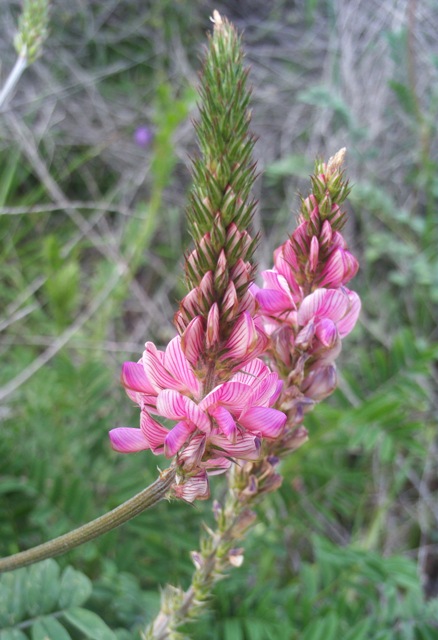
Onobrychis viciifoli or Sainfoin
A perennial herb of unimproved chalk grassland. Robust alien variants are also found on grassy banks, roadsides, arable margins, and by tracks on chalk and less often on other calcareous soils. They can be abundant on newly sown roadsides.
This is also known as O. sativa or common sainfoin has been an important forage legume in temperate regions until the 1950s. During the Green Revolution it was replaced by high yielding alfalfa and clover species.
Due to its anthelmintic properties the common sainfoin is a natural alternative to drugs to control nematode parasitism in the guts of small ruminants. This is the main reason why O. viciifolia came back to the scientific agenda during the last years. Especially in goat and sheep production systems feeding of O. viciifolia is a promising alternative or complement to synthetic drugs.
Besides these anthelmintic properties diets containing common sainfoin can lead to increasing daily weight gains of small ruminants. Also milk quantity and quality of these animals are not negatively affected by O. viciifolia intake. Furthermore, various studies showed that the voluntary intake of sainfoin was comparable or even higher than the intake of alfalfa or clover species.
Two different agricultural types of O. viciifolia are known. Compared to other forage legumes both types are weak in competition and their regrowth after mowing is considered to be low. Also the yields of common sainfoin are significantly lower than those of alfalfa and clover.
In terms of symbiotic nitrogen fixation from the atmosphere, common sainfoin is not as specific as other legumes. A relatively broad range of rhizobia genera is able to colonize the roots of O. viciifolia.
The common sainfoin is an open pollinating plant, mainly pollinated by nectar feeding insects. Therefore, O. viciifolia is a promising crop to enhance biodiversity within agro-ecosystems. The leaves of common sainfoin contain high levels of condensed tannins. This content can be more than five times higher than in clover species or alfalfa.
The chalk grassland form of O. viciifolia may be native, but the limits of its native distribution have been obscured by aliens. Agricultural variants were introduced in the 17th century and widely cultivated for fodder until the 19th century. The species is increasing as a constituent of wild-flower mixtures and as a contaminant of grass-seed.
Tribe 6: Loteae
Anthyllis vulneraria or Kidney Vetch
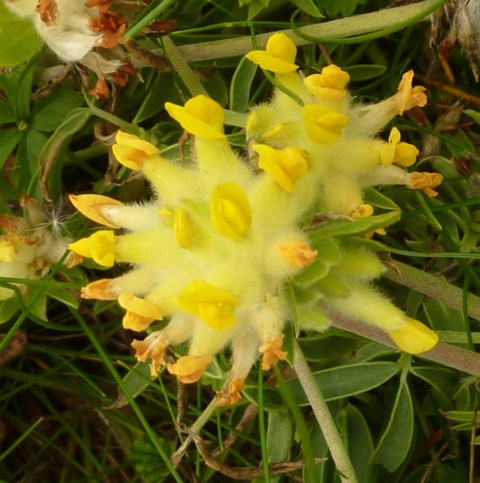
- A. vulneraria ssp. vulneraria
- A. vulneraria ssp. polyphylla (neophyte)
- A. vulneraria ssp carpatica (neophyte)
- A. vulneraria ssp lapponica
A perennial herb of rock outcrops and open turf on south-facing slopes, on free-draining neutral to base-rich, often calcareous, soils. By the coast it is found on sea-cliffs, shingle and sand dunes. It is increasing as an alien on roadsides where it is widely introduced in seed mixtures.
It has some medicinal uses according to Plants for a Future and the Medicinal Flora.
The roots, leaves and flowers are antitussive, astringent, laxative and vulnerary. This plant is an ancient remedy for skin eruptions, slow-healing wounds, minor wounds, cuts and bruises, it is applied externally.
Internally, it is used as a treatment for constipation and as a spring tonic. The plant can be used fresh in the growing season, or harvested when in flower and dried for later use.
In Switzerland, it is taken as a tonic beverage usually in a mixture with Wild Strawberry leaves and Blackthorn flowers.
Lotus spp. (or Bird’s foot trefoils)
A perennial herb of a wide variety of grasslands, including well-drained meadows, chalk and limestone downland, hill pastures and montane rock ledges; also on coastal cliff-tops, shingle and sand dunes. It is absent from only the most acidic and infertile soils. Non-native genotypes and forage cultivars are widely sown in seed mixtures, especially on arable field margins and on new roadside embankments.
Uses:
It is used in agriculture as a forage plant, grown for pasture, hay, and silage. It is a high quality forage that does not cause bloat in ruminants.. Taller-growing cultivars have been developed for this. It may be used as an alternative to alfalfa in poor soils.
A double-flowered variety is grown as an ornamental plant. It is regularly included as a component of wildflower mixes in Europe. It can also prevent soil erosion and provide a good habitat for wildlife.
In the traditional medicine of the Sannio regio of Italy, the diluted infusions were used for anxiety, insomnia, and exhaustion.
- L. pedunculatus or Greater Bird’s-foot-trefoil
- L. subbiflorus or Hairy Bird’s-foot-trefoil
- L. angustissimus or Slender Bird’s-foot-trefoil
- L. maritimus or Dragon’s-teeth (NN)
Lotus species are used as food plants by the larvae of some Lepidoptera species. Several species are culvivated for forage, including L. corniculatus, L. glaber, and L. pedunculatus. They can produce toxic cyanogenic glycosides which can be potentially toxic to livestock, but also produce tannins, which are a beneficial anti-bloating compound.
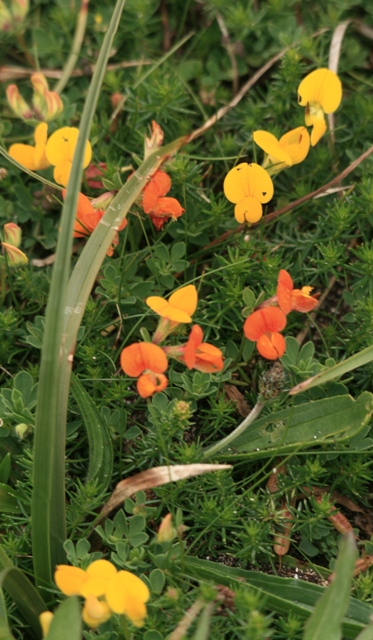
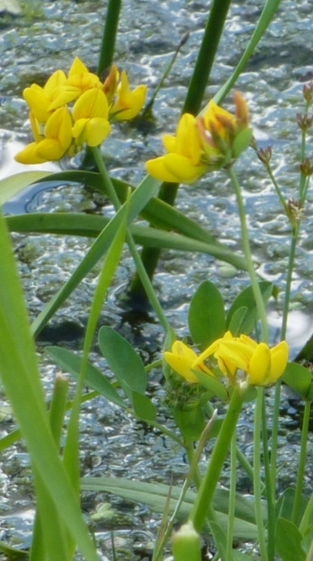
Species in this genus can fix nitrogen from the air courtesy of their root nodules, making them useful as a cover crop.
The five native species are all attractive plants. L. corniculatus or Common bird’s foot trefoil has also got the funny name as ‘Eggs and Bacon’. From the Med. Flora: The flowers are said to be calming, soporific and antispasmodic and are recommended in anxiety, depression and insomnia taken as an infusion.
Tribe 7: Coronilleae
- Ornithopus compressus or Yellow Serradella (NN)
- O. sativus or Serradella (NN)
A good green manure crop, fixing atmospheric nitrogen and forming a good weed-excluding ground cover
A winter-annual herb of short, open grassland on free-draining acidic sands and gravels; also around rock outcrops, on sand dunes and in bare patches on dry heathland. It is frequently found on drought-prone, sunny banks beside tracks and paths, and can quickly colonize bare areas after fires and other disturbances.
- O. pinnatus or Orange Bird’s- foot
- Coronilla valentina or Shrubby Scorpion-vetch (NN)
- C. scorpioides or Annual Scorpion-vetch (NN)
Hippocrepis comosa or Horseshoe Vetch
A perennial herb of dry, sunny pastures on chalk and limestone, and on rock ledges on limestone cliffs. It prefers a south-facing aspect and an open situation, and is able to colonize bare chalk, such as that in new road cuttings.
Hippocrepis comosa or Horseshoe Vetch is the exclusive food plant of the caterpillars of chalkhill blue (Polyommatus coridon) and Adonis blue (Polyommatus bellargus) butterflies. Populations that support such butterflies occur on longstanding, ungrazed meadows, quarries, edges of paths and wasteland. Outside of southern England and the Midlands (e.g. the Gower and Yorkshire populations) the climate is unsuitable for the butterflies.
- H. emerus or Scorpion Senna (NN)
- Securigera varia or Crown Vetch (NN)
- Scorpiurus muricatus or Caterpillar plant (NN)
Tribe 8: Fabeae
Here we find the large genus Vicia as well as the genus Lathyrus (Peas) with possibly 7 native species.
- Vicia benghalensis or Purple Vetch (NN)
- V. bithynica or Bithynian Vetch
- V. cracca or Tufted Vetch
- V. faba or Broad Bean (NN)
- V. lathyroides or Spring Vetch
- V. lens or Lentil (NN)
- V. lutea or Yellow-vetch
- V. narbonensis or Narbonne Vetch (NN)
- V. orobus or Wood Bitter-vetch
- V. pannonica or Hungarian Vetch (NN)
- V. sativa or Common Vetch
- V. sativa subsp. nigra or Narrow-leaved Vetch
- V. sepium or Bush Vetch
- Vicia tenuifolia or Fine-leaved Vetch (NN)
- Vicia villosa or Fodder Vetch (NN)
Vicia or Vetch
Vicia cracca or Tufted Vetch: A scrambling perennial herb of hedgerows, waysides, wood-borders, scrubby grassland, riversides and canal banks. It also occurs in permanent pastures and hay meadows, and in marshes and tall-herb fens, but avoids permanently wet sites.
A lot of information about this plant can be found on the Beehappy plant website.
Trying to grow some from seed this year to beautify my allotment!
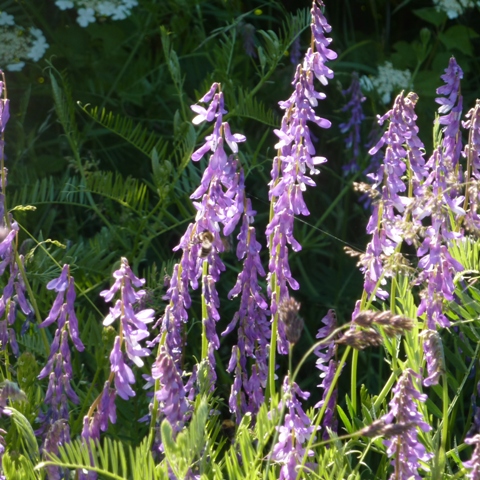
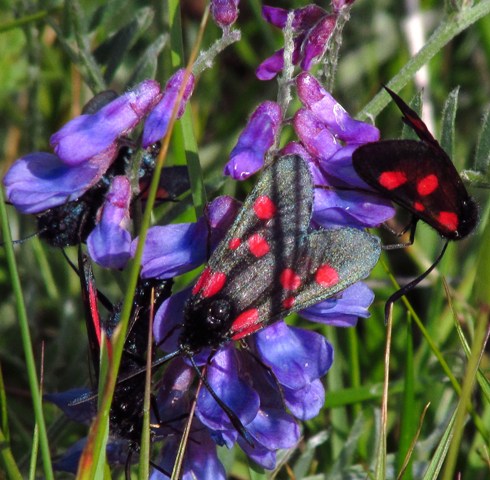
Forage for Pollinators: Produces a major amount of Pollen for bees which are declining, such as the short-haired bumblebee (Bombus subterraneus) and ruderal bumblebee (Bombus ruderatus) and the endangered mining bee (Andrena lathyri) which uses only this pollen for its brood, so is dependent on it.
Nectar is produced for Honeybees (though not in all years or localities), and like Broad beans, has extra-floral nectaries which likewise flow about two weeks before flowering.
All Bumblebees seem able to feed on its nectar either the flower or extra-floral nectaries.
Flowering time: May, June, July, August.
Growing information: Native perennial wildflower growing (scrambling) to 1.8 m (6ft). Prefers reasonably fertile, damp soils but is intolerant of permanently damp sites. These and all vetches have particularly suffered from modern, intensive agricultural practices.
This plant with pretty purple flower spikes, has limited capacity for vegetative spread and is mainly reliant on its large seed for regeneration. This coupled with its need of surrounding vegetation for support means it is mainly a hedgerow plant and rarely found in pasture of mown grassland. It can, however, become established in meadow, particularly those cut later in the season.
Also found edible and medicinal uses through the Plants for a Future website:
– Seed – cooked. They are boiled or roasted.
– Leaves and young stems – cooked.
– Used as a potherb.
– The leaves are a tea substitute.
– The cooked plant is used as a galactogogue (to increase lactation.)
– It can fix nitrogen and be used as a green manure.
Some uses for:
Vicia sativa or Common Vetch and V. sepium or Bush Vetch
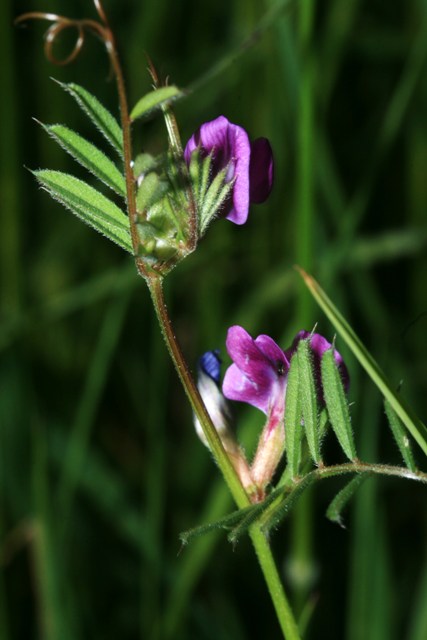
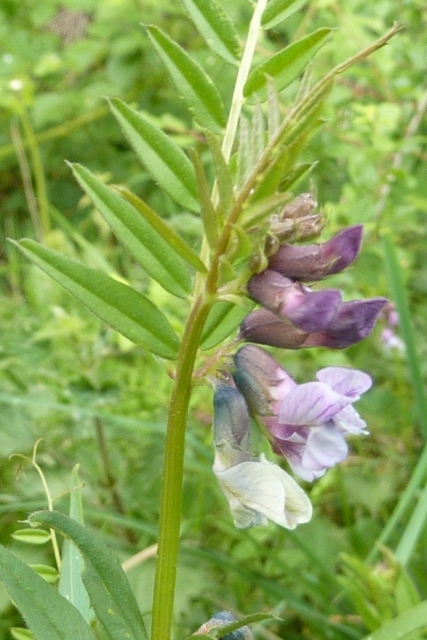
- The seed pods are edible (much like peas or beans) and although rarely eaten now, there is evidence to suggest ancient people commonly cultivated them for food.
- Like other legumes, it is very high in protein.
- It has been used medicinally to treat eczema and skin irritations.
- Also known as the Garden Vetch and Winter Tares. Local names include Twaddgers (Yorkshire), Gipsy Peas (Ireland), Wild Fitch (Cumbria).
Can be used as a fodder
Horses thrive very well on common vetch, even better than on clover and rye grass; the same applies to fattening cattle, which feed faster on vetch than on most grasses or other edible plants.
Danger often arises from livestock eating too much vetch, especially when podded; colics and other stomach disorders are apt to be produced by the excessive amounts devoured.
Cereal grains can be sown with vetch so it can use their stronger stems for support, attaching via tendrils. When grown with oats or other grasses, the vetch can grow upright; otherwise its weak stems may sprawl along the ground. Several cultivars are available for agricultural use, and as for some other legume crops, rhizobia can be added to the seed.
Common vetch has long been part of the human diet, as attested by carbonised remains found at early Neolithic sites in Syria, Turkey, Bulgaria, Hungary and Slovakia. It has also been reported from Predynastic sites of ancient Egypt, and several Bronze Age sites in Turkmenia and Slovakia. However, definite evidence for later vetch cultivation is available only for Roman times.
Three genera below which are named Vicia with many authorities are acoording to BSBI nowadays:
Some uses for Ervilia hirsuta:
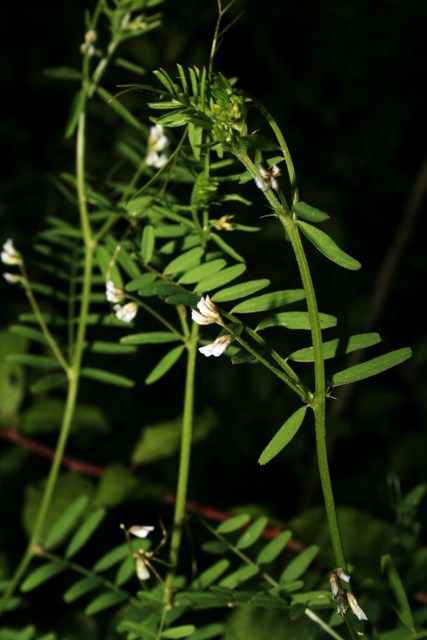
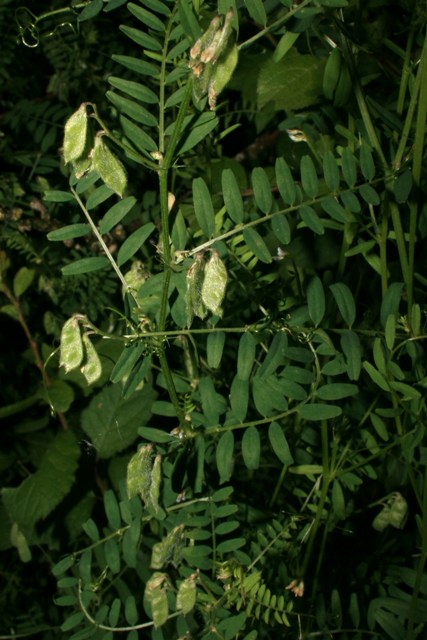
Hairy tare is commonly used in cover crops and green manures on farms in North America. Typically, common vetch or hairy vetch provides the leguminous component of the crop, usually mingled with a grassy component as a nurse crop and an addition of more cellulose to the resultant organic matter (for example, rye or winter wheat).
Seed – cooked. They are rich in protein and carbohydrates, but are best soaked before use (the soakwater being discarded) in order to get rid of a bitter substance.
Paste of leaves applied to treat cuts and wounds (CRC World Dictionary of Medicinal and Poisonous Plants)
Young leaves and shoots – cooked as a vegetable. A coffee substitute. The part used is not specified, it is almost certainly the roasted seed[Ken Fern from PFAF].
Lathyrus spp.
The genus Lathyrus possibly has 7 native species. The ornamental Sweet Pea and Everlasting Pea are in this genus and our natives look all like miniature versions of these.
- Lathyrus annuus or Fodder Pea (NN)
- L. aphaca or Yellow Vetchling (NN)
- L. grandiflorus or Two-flowered Everlasting-pea (NN)
- L. heterophyllus or Norfolk Everlasting-pea (NN)
- L. hirsutus or Hairy Vetchling
- L. latifolius or Broad-leaved Everlasting-pea (NN)
Lathyrus latifolius is a perennial herbaceous vine (climber), which can reach 6 feet or more by means of twining tendrils, but in open areas sprawls.
Numerous cultivars have been selected as garden subjects, of which the following have gained the Royal Horticultural Society‘s Award of Garden Merit:
- L. latifolius (pink)
- ‘Albus’ (white)
- ‘Rosa Perle’ (pale pink)
- ‘White Pearl’ (white)
Bumblebees pollinate the flowers. Butterflies visit the flowers for their nectar, but do not pollinate. Epicauta fabricii (Fabricius blister beetle), the caterpillars of Apantesis phyllira (Oithona tiger moth) and some herbivores feed on the leaves. However, the seeds are poisonous.
- L. linifolius or Bitter-vetch (NN)
- L. niger or Black Pea (NN)
- L. nissolia or Grass Vetchling
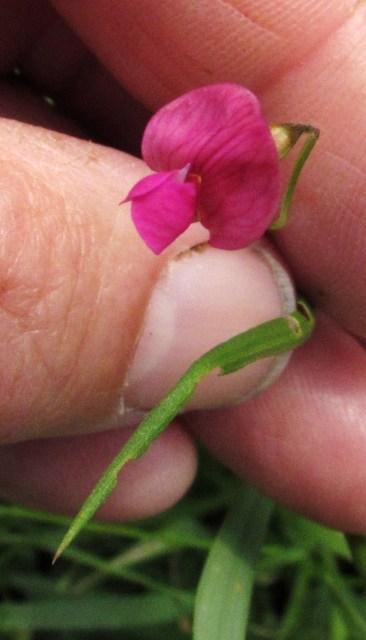
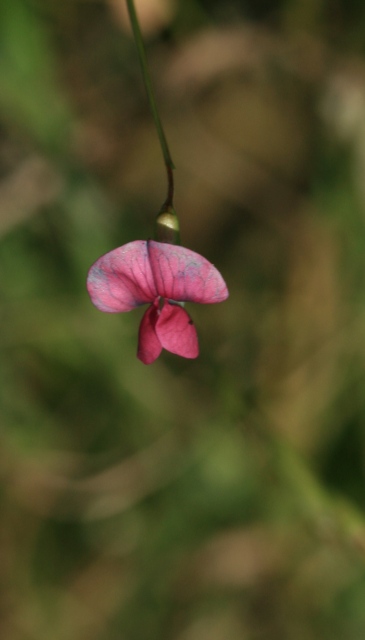
- L. odoratus or Sweet Pea (NN)
- L. oleraceus or Garden Pea (NN) formerly known as Pisum sativum
- L. palustris or Marsh Pea
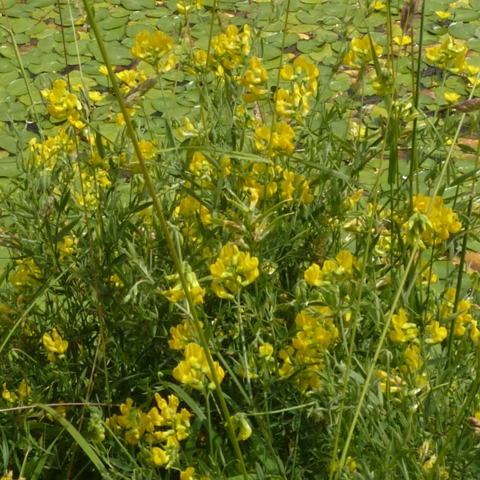
A rhizomatous perennial herb of moderately fertile soils on roadside and railway banks, hedges, unimproved pastures, hay meadows and other grassy habitats. Seed production is not abundant, and vegetative propagation from the rhizome is an important mechanism of reproduction, particularly in disturbed sites. It grows to 1.2 m. in height.
Lathyrus pratensis or Meadow Vetchling is the most common and best known one which has one medicinal use according to the PFAF website:
The seeds are used as a resolvent in Spain (= an agent capable of dispersing or absorbing inflammatory products.)
The hermaphrodite flowers are pollinated by bees. As a perennial, this plant reproduces itself over many years, spreading out from the point it was introduced, especially in damp grassy areas. This plant has been propagated in the past as animal fodder. It is also a host plant for ovipositioning of the wood white butterfly (Leptidea sinapis).
This plant is sometimes used to control erosion and for this purpose it is generally planted along with a grass species. It can do well in highly disturbed habitat.
- L. tuberosus or Tuberous Pea (NN)
A scrambling or climbing perennial herb with a tuberous rootstock, found on the margins and rides of woods and copses, in hedgerows and scrub, in rough grassland and in waste places; also occasionally found in arable field margins where its tubers allow it to persist.
Today in allotments of middle Europe, Lathyrus tuberosus is occasionally grown for its odour, its appearance and its edible tubers. In the 16th century flowers of the plant were distilled to produce perfume. In the 18th century in the Lower Rhine Valley of Germany and in the Netherlands it was grown on a larger scale. After harvesting, tubers were cooked or roasted for human nutrition. At the same time the root legume with the “gentle nutty flavor” was in demand on French markets. The production of fermented beverages or bread were occasional other uses of the tuber, whereas oil was pressed from the seeds. Promising experiments with L. tuberosus as a forage crop were conducted in the 20th century.
- L. vernus or Spring Pea (NN)
- L. japonicus or Sea Pea
Known edible uses from Plants for a Future:
- The immature seeds are eaten raw or cooked like peas.
- Mature seeds are cooked or sprouted and used in salads
- Young seedpods – raw or cooked when less than 25mm long
- The roasted seed is a coffee substitute
The seed contains a toxic amino-acid which, in large quantities, can cause a very serious disease of the nervous system known as ‘lathyrism’. The seed is said to be perfectly safe and very nutritious in small quantities, but should not comprise more than 30% of the diet.
Tribe 9: Cicereae
Cicer arietinum or Chick Pea (NN) FBBC
Tribe 10: Trifolieae
Here we find: Ononis (Restharrows), Melilotus (Melilots), Medicago (Medicks) and Trifolium (Clovers).
Ononis spp. or Restharrows
The Restharrows are an unusual small shrubby plant with pink flowers mostly found on rough grasslands and waysides on calcareous soils. I’ve also spotted it on the Northumberland coast.
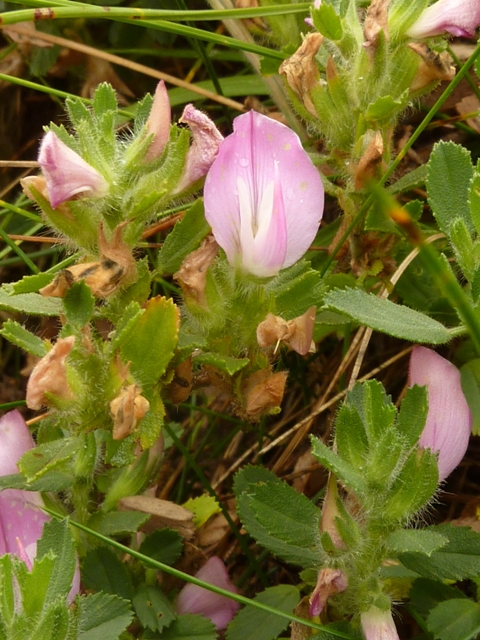
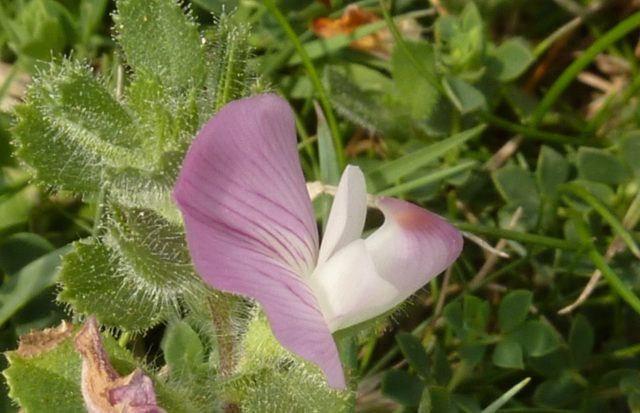
In J. Barker’s Medicinal Flora the Spiny Restharrow or Ononis spinosa is highly rated as a superb diuretic. It may be taken for generalised oedema; if of cardiac origin, it should be noted that this remedy tends to be hypotensive, especially if taken with other plants (which it should be). Its diuretic and mildly antiseptic properties mix well with other remedies for inflammations of kidney and bladder, and also as gargle for sore throats.
Restharrow contributes well to prescriptions for gout and ‘rheumatism’ but its anthilithic activity is disputed and may well be wishful thinking. The diuretic and anti-inflammatory activity is enhanced by the presence of volatile oil; therefore a long hot infusion is the best preparation while a decoction, even of the root, is to be avoided.
Melilotus spp. or Melilots
- Melilotus albus or White Melilot (NN)
- M. altissimus or Tall Melilot (archaeophyte)
- M. indicus or Small Melilot (NN)
- M. officinalis or Ribbed Melilot (or Sweet Clover) (NN)
- M. sulcatus or Furrowed Melilot (NN)
The Melilots have all got medicinal uses and the yellow flowered variety or Melilotus officinalis is in particular very attractive, with a lovely scent and bees find these very attractive.
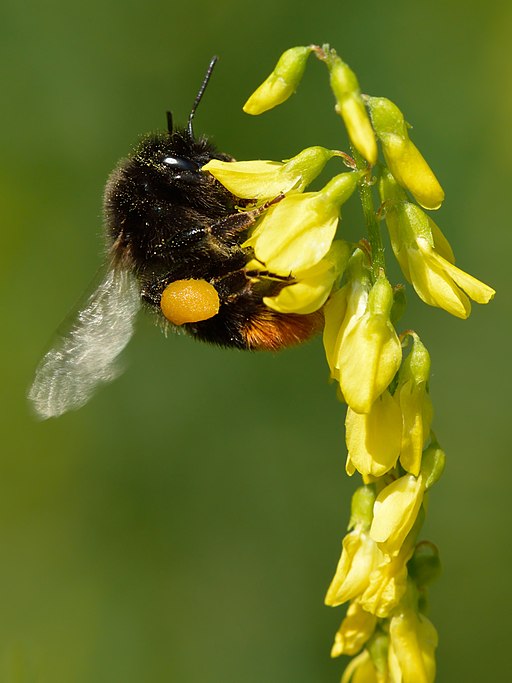
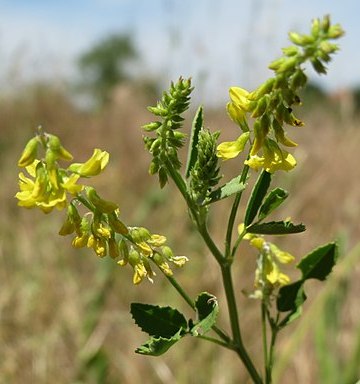
According to Med. Flora this is a plant of most ancient and very various usages. It was especially recommended as a poultice for swellings and bruises and also, internally, to remove some of the effects of drunkenness!
- Action: Mild sedative and antispasmodic. Anti-coagulant. Phlebotonic.
- Diuretic and urinary antiseptic. Antimicrobial. Emollient & mildly astringent.
- Uses: Insomnia, nervous tension and intestinal colic. Painful micturition.
- Varicose veins. Thrombophlebitis
- as a prophylactic for those already afflicted by coronary or cerebral thrombosis. Conjunctivitis, blepharitis.
- for styes (as compress).
- The seeds are eaten by game birds, including grouse.
- Ribbed Melilot or Sweet clover which is one other name, can be used as pasture or livestock feed. It is most palatable in spring and early summer, but livestock may need time to adjust to the bitter taste of coumarin in the plant.
- Prior to World War II before the common use of commercial agricultural fertilizers, the plant was commonly used as a cover crop to increase nitrogen content and improve subsoil water capacity in poor soils.
- It is the most drought-tolerant of the commercially available legumes. Sweet clover is a major source of nectar for domestic honey bees as hives near sweet clover can yield up to 200 pounds of honey in a year.
- It has been used as a phytoremediation—phytodegradation plant for treatment of soils contaminated with dioxins.
- In the chemical industry, dicoumarol is extracted from the plant to produce rodenticides.
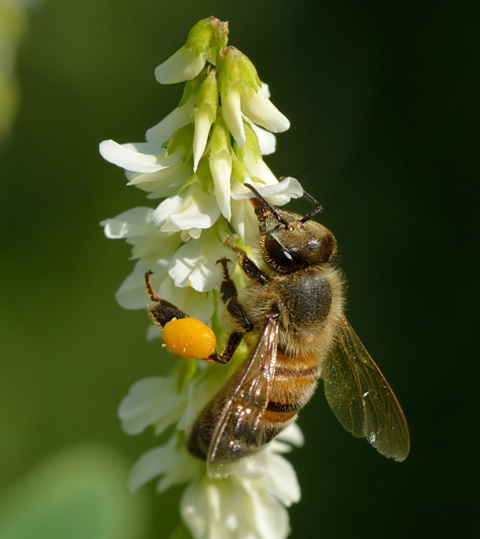
Melilotus albus or White melilot or Honey clover has similar properties to the yellow species. Its characteristic sweet odor, intensified by drying, is derived from coumarin. Like white sweetclover, yellow sweetclover (Melilotus officinalis) is erect, tall, and branching, but is distinguished by yellow rather than white flowers. Though they share most botanical characteristics, Melilot is typically found in drier habitats and has a tendency to flower about 2–4 weeks earlier than white melilot.
Trigonella foenum-graecum or Fenugreek (NN) FBBC
An annual herb of refuse tips and waste ground, where it arises from bird-seed and possibly as a result of small-scale cultivation as a spice.
Uses:
Fenugreek is used as a herb (dried or fresh leaves), spice (seeds), and vegetable (fresh leaves, sprouts, and microgreens). Sotolon is the chemical responsible for the distinctive maple syrup smell of fenugreek
Medicago spp. or Medicks
- Medicago arabica or Spotted Medick
- M. laciniata or Tattered Medick (NN)
- M. littoralis or Shore Medick (NN)
- M. lupulina or Black Medick
- M. minima or Bur Medick
- M. polymorpha or Toothed Medick
- M. praecox or Early Medick (NN)
- M. truncatula or Strong-spined Medick (NN)
- M. sativa subsp. falcata or Sickle Medick
- M. sativa nothosubsp. varia (M. sativa subsp. falcata × subsp. sativa) or Sand Lucerne
There are about 20 Mediterranean spp which have been found as aliens in wool and other sources, but all less commonly than the 6 treated in Stace.
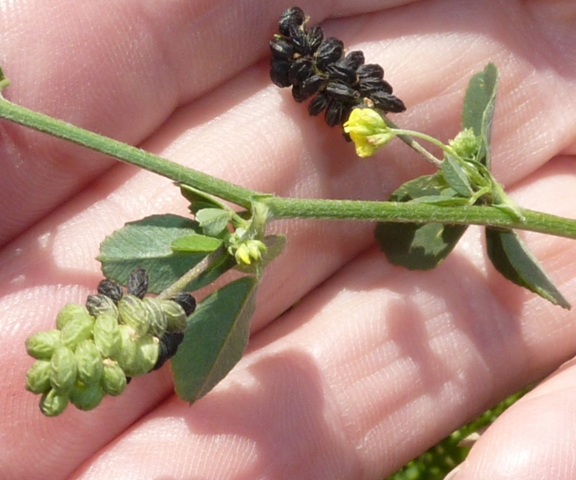
Black medick is one of the flowers used to make honey. It is frequently found in natural pastures, and may be planted in order to create artificial meadows, especially on dry land. The presence of black medick in large concentrations as a lawn weed may indicate that the soil is poor in nitrogen. However, because black medick and other clovers fix nitrogen in the soil, this deficiency can improve over time due to the presence of these plants.
Black medick is sometimes used as a fodder plant. Its hardiness and ability to grow in poor soils, as well as its tendency to fix nitrogen in the soil, make black medick a good choice for pasturage, although its fodder value is limited. It is grazed by sheep but is not very palatable to cattle.
M. sativa and ssp. falcata or Sickle Medick, M. sativa Nothossp. varia or Sand Lucerne and M. sativa ssp. sativa or Lucerne (also called Alfalfa) which was introduced as a crop and now occasionally naturalized. M. minima or Bur Medick, M. polymorpha or Toothed Medick with edible uses according to Plants for a Future and M. arabica or Spotted Medick.
Many of the small flowered are native to the Mediterranean basin but are found throughout the world. They form a symbiotic relationship with the bacterium Sinorhizobium medicae, which is capable of nitrogen fixation.
Trifolium or Clover
- Trifolium alexandrinum or Egyptian Clover (NN)
- T. angustifolium or Narrow-leaved Clover (NN)
- T. arvense or Hare’s-foot Clover
- T. aureum or Large Trefoil (NN)
- T. bocconei or Twin-headed Clover
- T. campestre or Hop Trefoil
- T. dubium or Lesser Trefoil
- T. echinatum or Hedgehog Clover (NN)
- T. fragiferum or Strawberry Clover
- T. glomeratum or Clustered Clover
- T. hybridum or Alsike Clover (NN)
- T. incarnatum subsp. incarnatum or Crimson Clover (NN)
- T. incarnatum subsp. molinerii or Long-headed Clover
- T. medium or Zigzag Clover
- T. micranthum or Slender Trefoil
- T. occidentale or Western Clover
- T. ochroleucon or Sulphur Clover
- T. ornithopodioides or Bird’s-foot Clover
- T. pannonicum or Hungarian Clover (NN)
- T. pratense or Red Clover
- T. repens or White Clover
- T. resupinatum or Reversed Clover
- T. striatum or Knotted Clover FBBC
There are well over 200 species of Trifolium in the world and 100 in Europe (from Med. Flora) and (in Stace) about 15 true natives in the B.I. Julian Barker gives an interesting account of the uses of Clover and how the medicinal practises travelled from America back to Britain.
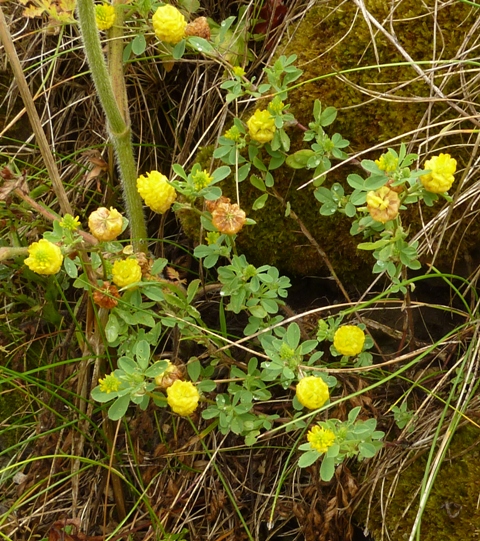
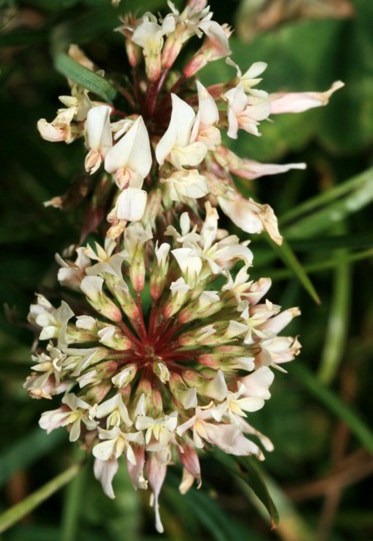
Clovers are an important agricultural and fodder crop in spite of cyanogenic glycocides which some species contain, (notably White clover or Trifolium repens) along with other compounds which may subject ruminants to a number of problems.
Trifolium repens or White Clover
This is probably the best known of all the clovers and also the most common one in all grassy areas as well as in cultivation.
Uses:
- The flowers are mostly visited by bumblebees and often by honey bees.
- White clover has been described as the most important forage legume of the temperate zones.
- White clover is commonly grown in mixtures with forage grasses, e.g. perennial ryegrass (Lolium perenne). Such mixtures can not only optimize livestock production, but can also reduce the bloat risk to livestock that can be associated with excessive white clover in pastures. Companion planting, green manure, and cover crops.
- White clover grows well as a companion plant among lawns, grain crops, pasture grasses, and vegetable rows.
- It is often added to lawn seed mixes, as it is able to grow and provide green cover in poorer soils where turfgrasses do not perform well.
- White clover can tolerate close mowing and grazing, and it can grow on many different types and pHs of soil (although it prefers clay soils).
- As a leguminous and hardy plant, it is considered to be a beneficial component of natural or organic pasture management and lawn care due to its ability to fix nitrogen and out-compete weeds.
- Natural nitrogen fixing reduces leaching from the soil and by maintaining soil health can reduce the incidence of some lawn diseases that are enhanced by the availability of synthetic fertilizer.
- For the above reasons, it is often used as a green manure and cover crop.
Culinary uses:
- It is an excellent forage crop for livestock
- The leaves and flowers are a valuable survival food: they are high in proteins, and are widespread and abundant. The fresh plants have been used for centuries as additives to salads and other meals consisting of leafy vegetables.
- They are not easy for humans to digest raw, however, but this is easily fixed by boiling the harvested plants for 5–10 minutes.
- Dried white clover flowers may also be smoked as an herbal alternative to tobacco.
Medicinal uses:
In India, T. repens is considered a folk medicine against intestinal helminthic worms, and an experimental in-vivo study validated that the aerial shoots of T. repens bear significant anticestodal properties.
From Med. Flora: The contemporary usage is not more than 200 years old and is more or less confined to the Anglo-American tradition. The Thompsonian or Physiomedical systems of herbal medicine were brought in Britain in the first half of the 19th century by a Dr Coffin. He revived interest in indigenous herbal remedies and introduced a number of American ones. His writings and public lectures were a great success especially in the industrial cities of the north which saw a rebirth of both the trade in herbal remedies and in their use by professional herbalists. It was the seedbed for the formation of the National Institute of Medical Herbalists which traces its inception to 1864.
Trifolium pratense or Red Clover is one of the remedies which has returned this way from America.
This is probably the second best known clover in the British Isles.
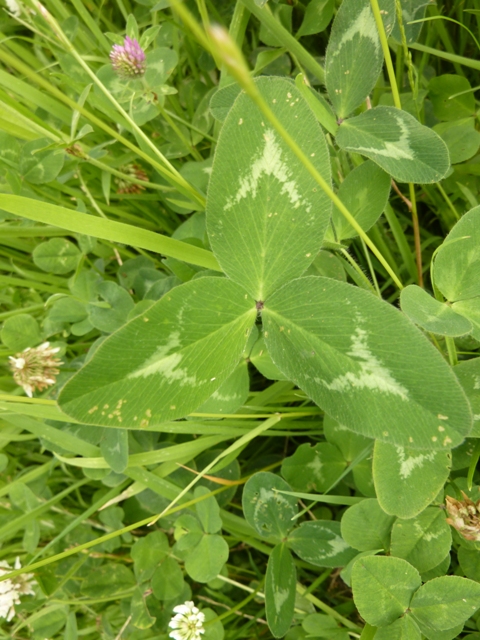
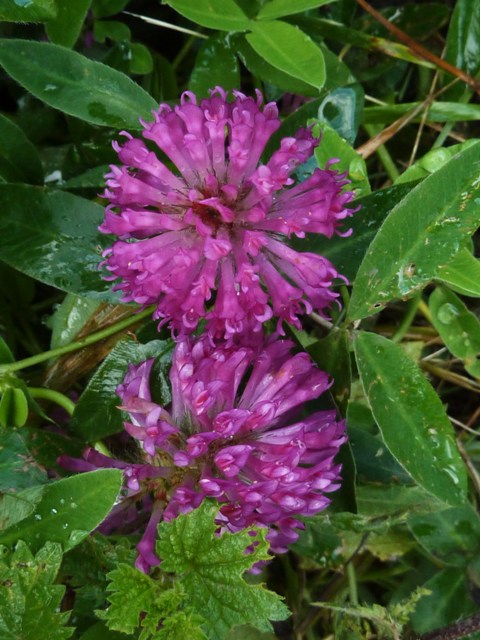
- Fodder, green manure. Several cultivar groups have been selected for agricultural use, mostly derived from T. pratense var. sativum.
- Due to its beauty, it is used as an ornamental plant.
- Red clover’s flowers and leaves are edible, and can be added as garnishes to any dish. They can be ground into a flour.
- The flowers often are used to make jelly and tisanes, and are used in essiac recipes.
- Their essential oil may be extracted and its unique scent used in aromatherapy.
Medicinal Uses:
Action: dermatological agent; mild antispasmodic; expectorant.
Uses: Chronic skin disease, especially eczema.
- Red Clover is used in traditional medicine of India as deobstruent, antispasmodic, expectorant, sedative, anti-inflammatory and antidermatosis agent.
- In alternative medicine, red clover is promoted as a treatment for a variety of human maladies, including symptoms of menopause, coughs, disorders of the lymphatic system and a variety of cancers.
- Red clover contains coumestrol, a phytoestrogen.Due to its activity on oestrogen receptors, red clover is contraindicated in people with a history of breast cancer, endometriosis, ovarian cancer, uterine cancer, uterine fibroids or other oestrogen-sensitive conditions,although some authors have suggested the high isoflavone content counteracts this, and even provides benefits in these conditions.
Due to its coumarin derivatives, T. pratense should be used with caution in individuals with coagulation disorders or currently undergoing anticoagulation therapy.
It is metabolised by CYP3A4 and therefore caution should be used when taking it with other drugs using this metabolic pathway.
Tribe 11: Thermopsideae or False Lupin
Thermopsis montana or False Lupin (NN)
A rhizomatous, perennial herb, found as a naturalized garden escape in gravel-pits, on riverbanks and in rough grassy places. It also occurs as a relic of cultivation.
It is used as a medicinal plant, where it is native to the western United States.
Here mainly used as an ornamental plant in gardens.
Tribe 12: Genisteae
Here on the end of this long post we find mainly the woody plant members; Cytisus (Brooms), Genista (Greenweeds) and Ulex (Gorses).
Lupinus spp. (all NN)
- Lupinus arboreus or Tree Lupin FBBC
- L. x regalis or Russell Lupin FBBC
- L. albus or White Lupin
- L. angustifolius or Narrow-leaved Lupin
- L. nootkatensis or Nootka Lupin
- L. polyphyllus or Garden Lupin
Laburnum spp. (all NN)
- Laburnum anagyroides or Laburnum FBBC
- L. x wateri or Hybrid Laburnum FBBC
- L. alpinum or Scottish Laburnum FBBC
Cytisus spp. or Broom
- Cytisus multiflorus or White Broom (NN)
- C. nigricans or Black Broom (NN)
- Cytisus scoparius or Broom
- Cytisus scoparius subsp. maritimus or Prostrate Broom
- C. striatus or Hairy-fruited Broom
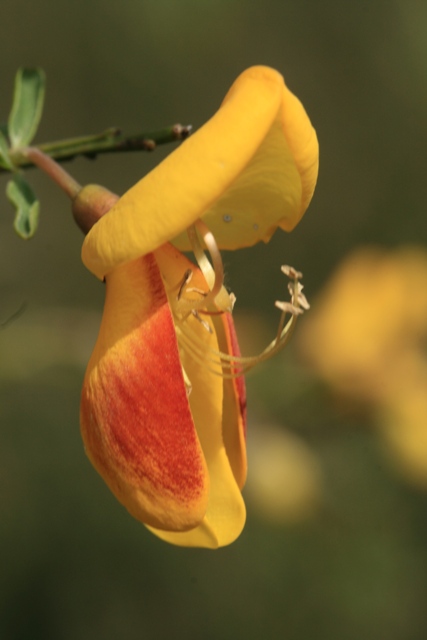
Cytisus scoparius or Broom
An erect shrub of sandy acidic soils, on heaths, open woodland, railway banks, stony riversides and, particularly, on roadside banks and verges where it may often be planted. The prostrate subsp. maritimus grows on western sea-cliffs.
The Broom’s botanical name has changed on a number of occasions but is now called Cytisus scoparius. Most of its common and historical names refer to the use of the stems as brooms. From various sources was found that eating the plant confers a degree of protection and an antidote to snakebites.
- Broom contains scoparin, which is a diuretic.
- The plant also is used as a cathartic and as a cardiac stimulant which is credited to the presence of sparteine.
- A decoction or infusion of broom can be used to treat dropsy due to its diuretic action.
- An ointment can be made from the flowers to treat gout.
- Oxysparteine, produced from the action of acid on the sparteine, is useful as a cardiac stimulant and has the advantage over digoxin that it does not accumulate in the body.
The whole plant is very attractive both with or without flowers. Various cultivars are available at good nurseries, for example see here
In Welsh mythology, Blodeuwedd is the name of a woman made from the flowers of broom, meadowsweet and the oak by Math fab Mathonwy and Gwydion to be the wife of Lleu Llaw Gyffes. Her story is part of the Fourth Branch of the Mabinogi, the tale of Math son of Mathonwy.
Broom was considered a sign of plenty when it bore many flowers.
However a traditional rhyme from Sussex warns: “Sweep the house with blossomed broom in May/sweep the head of the household away.”
Broom was also used in a decorated bundle of broom at weddings in place of rosemary when that was scarce, and its strong smell was said to be able to tame wild horses and dogs.
In Italy, the shrub was burnt to stop witches.
The name of the House of Plantagenet, rulers of England in the Middle Ages, may have been derived from common broom, which was then known as planta genista in Latin.The plant was used as a heraldic badge by Geoffrey V of Anjou and five other Plantagenet kings of England as a royal emblem.The “broomscod”, or seed-pod, was the personal emblem of Charles VI of France.
Spartium junceum or Spanish Broom
A deciduous shrub, widely grown in gardens and planted in amenity areas and on roadsides. It sets seed readily and can quickly become naturalized on light soils by roads, railways, and along coastal cliffs.
Genista spp.
- Genista aetnensis or Mount Etna Broom (NN)
- G. anglica or Petty Whin
- G. hispanica or Spanish Gorse (NN)
- G. monspessulana or Montpellier Broom (NN)
- G. pilosa or Hairy Greenweed
- G. tinctoria or Dyer’s Greenweed
Properties and uses:
Numerous cultivars have been selected for garden use, of which ‘Royal Gold’ has gained the Royal Horticultural Society‘s Award of Garden Merit.
The plant, as its Latin and common names suggest, has been used from ancient times for producing a yellow dye, which combined with woad also provides a green colour.
It was from this plant that the isoflavone genistein was first isolated in 1899; hence the name of the chemical compound. The medicinal parts are the flowering twigs.
The plant has been used in popular medicine and herbalism for various complaints, including skin diseases, even in modern times.
It was mentioned by both Gerard and Parkinson. It has some affinities with Broom and with which it shares the possession of quinolizidine alkaloids, a flavone and a yellow glycoside. It was well known as a dye and apparently mixes well with Woad to produce an excellent green. Similar Actions and Uses to Broom but much weaker.
Another pretty plant is Genista pilosa or hairy greenweed, silkyleaf broom, silkyleaf woadwaxen and creeping broom, to give five of its common used names!
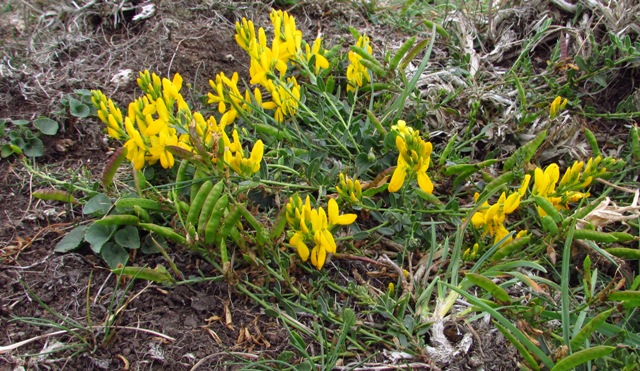
Finally, probably the most common Legume in many parts of the British Isles which is the Gorse.
Ulex spp. or Gorse
- Ulex europaeus or Gorse
- U. gallii or Western Gorse
- U. minor or Dwarf Gorse
Ulex europaeus or common gorse, furze or whin, must be one of our longest flowering native plants. It is rarely out of flower here locally where it is abundant all along the Sutton Road of the Barr Beacon outside Walsall!
Uses:
- A welcome sight in autumn to spring. The flowers bear a lovely coconut scent.
- This is a plant which, in the case of need, will be considered useful but which will otherwise be neglected. If burnt, the alkaline ash will be of benefit as a fertiliser and has also been made into soap.
- The young shoots are edible and saved lives in the Irish Famine. So are the seeds though the latter has been said to yield a cardioactive alkaloid.
- Gorse flowers are one of ‘The Four Helpers’ of Dr Edward Bach and are indicated for Despair.
Like many species of gorse, it is often a fire-climax plant, which readily catches fire but re-grows from the roots after the fire; the seeds are also adapted to germinate after slight scorching by fire. It has a tap root, lateral and adventious roots. An extremely tough and hardy plant, it survives temperatures down to −20 °C. It can live for about thirty years.
- This plant is used for hedging, boundary definition and groundcover in suitably sunny, open locations.
- Ornamental varieties or Cultivars include ‘Strictus’ (Irish gorse), a dwarf form, and the double-flowered, non-fruiting ‘Flore Pleno’, which has gained the Royal Horticultural Society‘s Award of Garden Merit.
- Bruised gorse was used in some areas for feeding to horses and other livestock.
- Lectin extracted from seeds of this species binds to, is remarkably specific for, and is the standard method for identification of H-substance (absent in the hh antigen system) on human red blood cells. The vast majority of humans express H-substance, which is the basis for the ABO blood group system, but a few rare individuals (“Bombay phenotype“) do not—and a chemical isolated from Ulex europaeus is used to identify these individuals. This lectin is also used as a marker for human vascular endothelial cells and as a tool for their isolation for in-vitro culture.
- It fixes nitrogen into the soil.
Ulex minor (Dwarf gorse)
Due to its relatively soft spines, Dwarf furze is readily grazed by livestock and wild herbivores.
The distributions of Dwarf furze and its close relative Western gorse (Ulex gallii) hardly overlap, even in similar habitats.
and finally, Ulex galii (Western gorse).
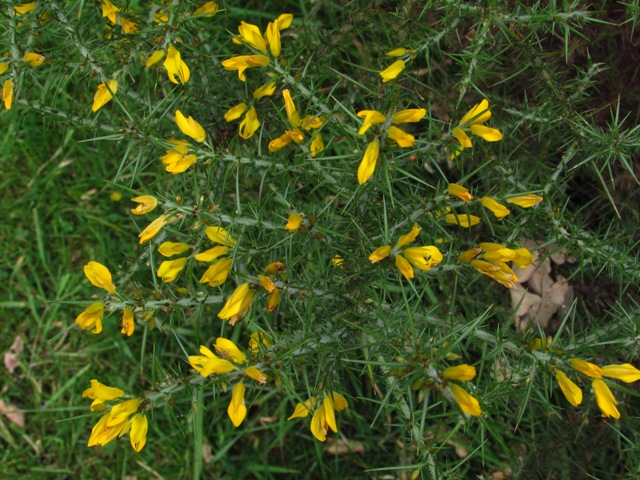
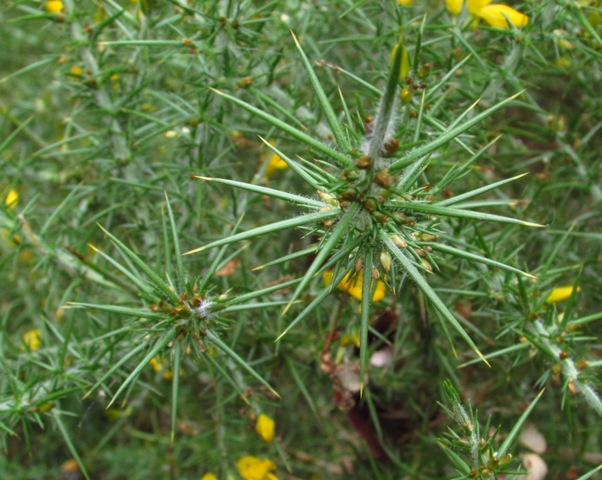
This favours acidic heathy soils and is frequently found in exposed maritime and montane environments. It is more common in the west of its distribution; in eastern England it is replaced in similar habitats by the closely related Dwarf furze (Ulex minor), with very little overlap in the distribution of the two species. Like many species of gorse, it can grow as a fire-climax plant, which readily catches fire but re-grows from the roots after the fire; the seeds are also adapted to germinate after slight scorching by fire.
